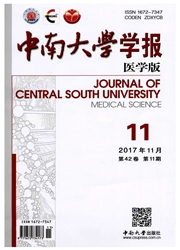

 中文摘要:
中文摘要:
目的:神经胶质细胞介导的炎性反应与中枢神经系统多种病理过程有关,本研究旨在探讨静脉麻醉药对神经系统炎性损伤可能的保护作用。方法:本研究采用体外原代培养神经胶质细胞,以细菌脂多糖(LPS)诱导神经胶质细胞的炎性反应,实验分为8组:空白对照组(C组)、LPS对照组(L组)、100μmol/L氯胺酮加LPS组(K1组)、1000μmol/L氯胺酮加LPS组(K2组)、30μmol/L丙泊酚加LPS组(P1组)、300μmol/L丙泊酚加LPS组(P2组)、3μmol/L咪唑安定加LPS组(M1组)和30μmol/L咪唑安定加LPS组(M2组),放射免疫法检测神经胶质细胞的炎性介质TNF-α的产生。结果:L组、K1组、K2组、P1组、P2组、M1组和M2组TNF-α较C组明显增高,差异有统计学意义(P〈0.05)。K1组和K2组较L组TNF-α的生成减少,差异有统计学意义(P〈0.05),P1组、P2组、M1组和M2组与L组比较差异无统计学意义(P〉0.05)。结论:氯胺酮可抑制神经胶质细胞的炎性反应中的TNF-α的释放,由此产生一定的抗炎作用。而丙泊酚和咪唑安定对LPS诱导的神经胶质细胞的TNF-α的产生无明显影响。
 英文摘要:
英文摘要:
Objective To investigate the effects of intravenous anesthetics on LPS-induced inflammatory responses of primary cultures of rat glial cells in vitro. Methods The primary cultures of rat glial cells were stimulated with lipopolysaccharide ( LPS ) to produce inflammatory responses. Glial cells were divided into 8 groups (n =4) : blank control (Group C) , LPS( Group L) , 100 μmol/L ketamine with LPS (Group K1 ), 1 000 μmol/L ketamine with LPS (Group K2 ), 30 μmol/L propofol with LPS (Group P1 ), 300 μmol/L propofol with LPS (Group P2 ) , 3 μmol/L midazolane with LPS (Group M1 ) , and 30 μmol/L midazolane with LPS (Group M2 ). TNF-α released into the culture media was measured by radioimmunity assay. Results Compared with the blank control Group C, LPS-induced TNF-α productions in Group L, K1, K2, P1, P2, M1 and M2 increased significantly. The levels of TNF-α in Group K1 and K2 were significantly lower than those in Group L ( P 〈 0.05 ), but TNF- α productions in Group P1, P2, M1 and M2 were not significantly different as compared with that in Group L. Conlusion Ketamine can reduce LPS- induced TNF- α production of glial cells, thereby inhabiting some of the inflammatory responses. Propofol and midazolam have no effect on the production of TNF-α from LPS-stimulated glial cells.
 同期刊论文项目
同期刊论文项目
 同项目期刊论文
同项目期刊论文
 期刊信息
期刊信息
